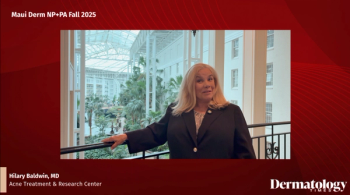
- Dermatology Times, July 2020 (Vol. 41, No. 7)
- Volume 41
- Issue 7
Study evaluates topical plus device for rosacea treatment
Oxymetazoline (Rhofade, EPI Health) in combination with energy-based devices was safe and effective at reducing the persistent facial erythema associated with erythematotelangiectatic rosacea (ERT), according to a recent study.1
“Energy-based devices are very commonly used in the dermatology practice today, and combining these technologies with topical oxymetazoline in rosacea not only appears to be a safe treatment approach but also effective in reducing the persistent erythema in these patients, positively impacting their quality of life,” says Emil A. Tanghetti, M.D., Center for Dermatology and Laser Surgery, Sacramento, Calif., and lead author of the study.
Dr. Tanghetti and fellow researchers investigated the safety, efficacy and tolerability of oxymetazoline hydrochloride 1% cream when combined with different energy-based devices in the treatment of moderate-to-severe erythema. The multicenter, open-label, interventional study included 46 patients with rosacea (mean age 51.1 years; 78.3% female). Similar numbers of patients received one of four energy-based therapies (KTP laser, IPL therapy, pulsed-dye laser Vbeam Perfecta, or pulsed-dye laser Cynergy) on day one and day 29 and once-daily application of oxymetazoline on days three through 27 and days 31 through 56.
Compared to baseline, results showed that all patients achieved an improvement in the Clinician Erythema Assessment (CEA) score during the study with 39 of 43 evaluable patients (90.7%) demonstrating an improvement six hours post-treatment on day 56. Most patients were satisfied or very satisfied with treatment outcomes. All of the treatment-emergent adverse events were mild or moderate in severity, and some patients experienced worsening in dermal tolerability assessment symptoms. The worsening in CEA and Clinician Telangiectasia Assessment (CTA) were each reported by three patients (6.5%) during the study.
Vascular targets are challenging especially when dealing with diffuse erythema, Dr. Tanghetti says. Diffuse erythema is partly vascular reactivity and partly dilatation of the very small capillary loops. These small vessels are very hard to hit with energy-based therapies without creating purpura. According to Dr. Tanghetti, there is a synergy between oxymetazoline and energy-based devices that makes this approach worthwhile.
“The idea that if you can have something that can constrict these very reactive vessels that are responding to different chemical factors in the skin gives credence to the notion that one could potentially treat all forms of rosacea with it. There is a synergy here because the vascular reactivity is part of the whole rosacea complex,” Dr. Tanghetti says.
In another recent study2 investigating the microvascular effects of pulsed dye laser in combination with oxymetazoline, researchers found that the synergy appears from the pathophysiology of the generation of factors involved with vascular destruction, and the drug itself. It is probably better to apply the drug very soon after or around the same time as the laser treatment, rather than wait a couple of days.
Due to the target size of diffuse erythema in rosacea patients, effectively treating the erythema alone with the currently available energy-based therapies is challenging. According to Dr. Tanghetti, it appears one can actually improve clinical outcomes in rosacea by treating the telangiectasias which are larger vessels that do not respond to oxymetazoline, by using both treatment modalities together.
“I think it is very exciting to have a drug that is safe to use and might enhance the effects of a vascular treatment such as in rosacea. The future of oxymetazoline is bright when used alone or in conjunction with energy-based therapies for rosacea patients with persistent facial erythema,” Dr. Tanghetti says.
Disclosures:
Dr. Tanghetti reports no relevant disclosures.
References:
1 Tanghetti EA, Goldberg DJ, Dover JS, Geronemus RG, Bai Z, Alvandi N, Shanler SD. Oxymetazoline and energy-based therapy in patients with rosacea: evaluation of the safety and tolerability in an open-label, interventional study. Lasers Surg Med. [Epub ahead of print May 6, 2020]
2 Kelly A, Pai A, Lertsakdadet B, Choi B, Kelly KM. Microvascular effects of pulsed dye laser in combination with oxymetazoline. [Epub Nov 22, 2019]. Lasers Surg Med. 2020 Jan;52(1):17-22.
Articles in this issue
over 5 years ago
Injection technique aims to optimize outcomesover 5 years ago
COVID-19: Counseling patients on biologic useover 5 years ago
COVID-19 impact in patients on biologicsover 5 years ago
Immunotherapy implications for NMSCover 5 years ago
Apremilast treatment in a patient with COVID-19over 5 years ago
An examination of rosacea treatment satisfactionover 5 years ago
IL-17 inhibition a path of interest in rosacea treatmentover 5 years ago
Acne topical efficacy mixedover 5 years ago
Patient appearance challengesover 5 years ago
Physical sunscreens sidestep concernsNewsletter
Like what you’re reading? Subscribe to Dermatology Times for weekly updates on therapies, innovations, and real-world practice tips.


















